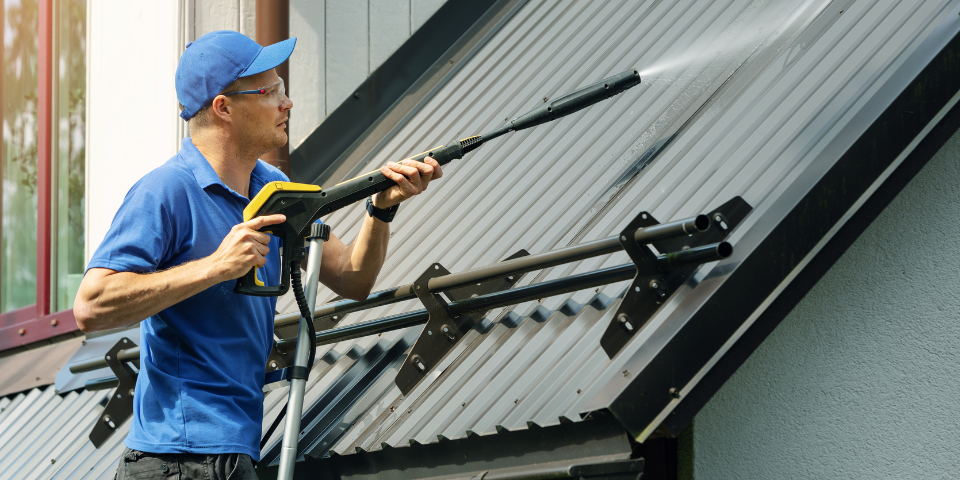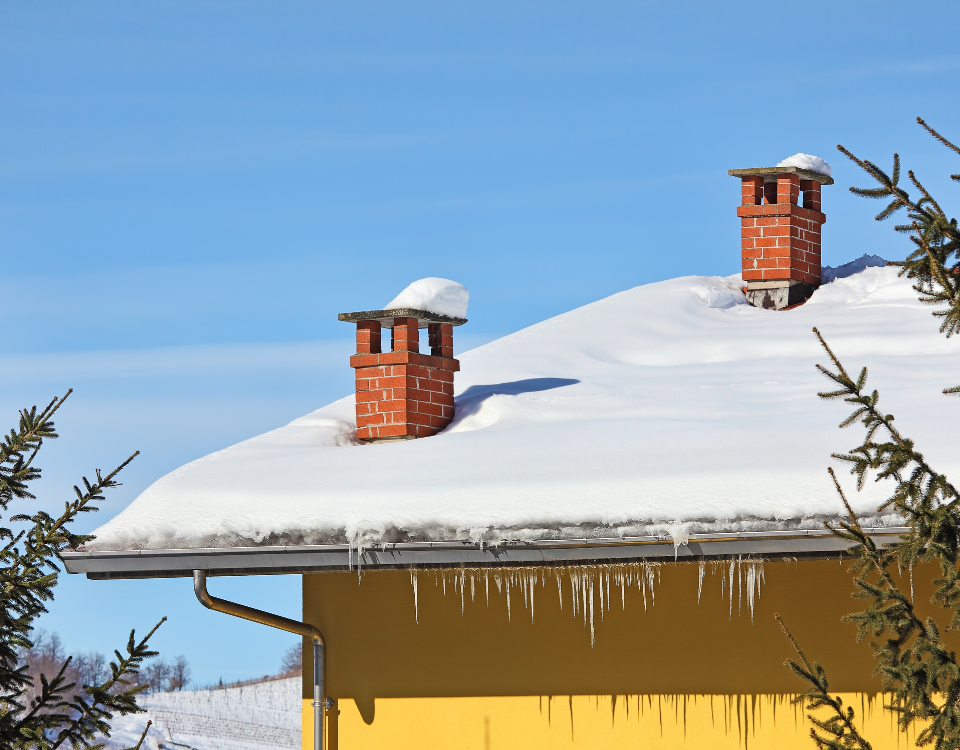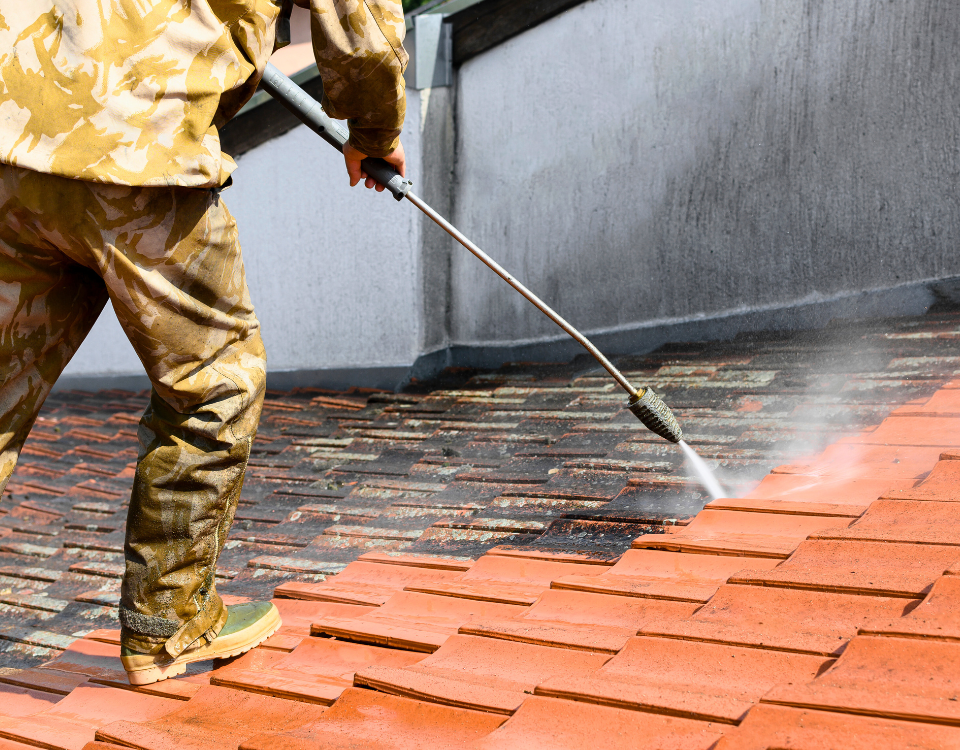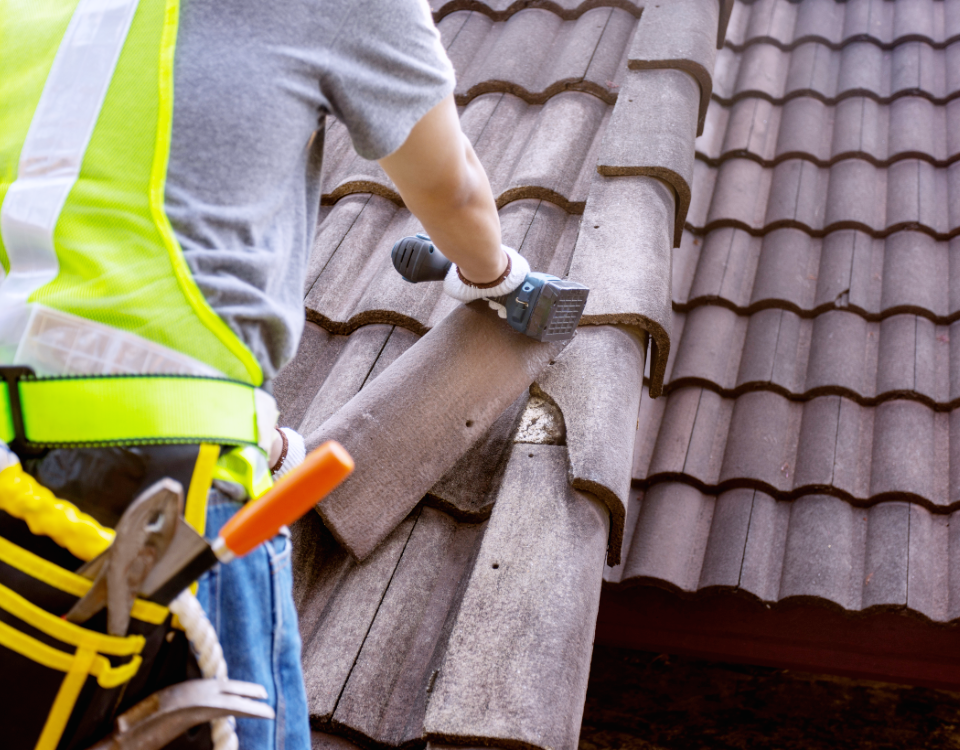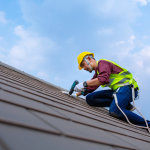
Does Homeowners Insurance Cover a New Roof?
July 7, 2024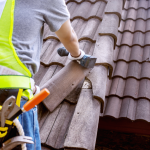
What to Do When Your Roof Needs Emergency Repair
October 28, 2024Key Takeaways:
- Roof washing services are broadly categorized into pressure washing and soft washing techniques.
- Pressure washing utilizes high-pressure water streams to remove tough stains and debris—NEVER PRESSURE WASH AN ASPHALT ROOF! Pressure washing asphalt will blast the protective granules from the shingles and can even damage the fiberglass mat, which is the structural core of a shingle. There are a few circumstances where it may be appropriate to pressure wash some hard roof surfaces, but that carries its own set of challenges.
- Soft washing involves a gentler approach, allowing chemical blends to do the cleaning without removing the granules or damaging the structure of the shingles.
- Safety precautions are paramount during roof washing to prevent accidents and injuries. This includes using proper equipment, protective gear, and following established safety measures.
- The process of roof washing typically involves property inspection, preparation, cleaning out gutters to ensure controlled solution runoff, cleaning/treatment of the roof, followed by a rinse and final inspection to ensure the property’s cleanliness and integrity.
- The frequency of roof washing depends on factors like climate, the surrounding environment, tree coverage, and the presence of debris or mold. Regular inspections and maintenance contribute significantly to the longevity and overall well-being of the roof.
Purpose and Importance of Roof Washing: Roof washing services aim to maintain the cleanliness and aesthetic appeal of a roof, prevent black algae from thriving, mold growth from flourishing, and mitigate the degree to which moss can survive. All of these conditions can degrade a property’s appearance and value over time. In some circumstances, it can even reduce heat and moisture absorption, enhancing energy efficiency.
Types of Roof Washing Techniques:
Safety and Maintenance Considerations:
Are you curious about the specifics of roof cleaning services and how important they can be to the appearance of your home? This extensive guide explores the benefits of keeping a clean roof, the range of services available, and the fundamentals of roof washing.
With all the information you need, we can help you determine when your roof needs to be washed and also explain the safety precautions to take. Learn more about roof washing and get an idea of possible costs by continuing to read!
Understanding Roof Washing Services
Roof washing services involve professional cleaning and maintenance procedures aimed at enhancing the exterior appearance and longevity of a house or property’s roofing structure. These services typically encompass thorough cleaning to remove debris, black algae, and staining. This process can include moss growth as well, but moss removal requires an agitation process to remove the organic matter. Moss often can’t be fully removed, as the level of agitation required to do so would damage the roof shingles. Getting the majority of the moss off and following the moss agitation with soft wash solution cleaning can kill off the roots of the moss.
By investing in regular roof washing services, homeowners can not only improve the aesthetic appeal of their property but also extend the lifespan of their roofs by preventing damage caused by organic growth.
The Purpose of Roof Washing
Roofs often make up a large amount of a property’s viewable exterior viewable from the street. Have you ever looked up at your roof and noticed black streaks on the shingle slopes? Consider how this affects your home’s curb appeal. These black streaks hide the roof’s uniform hue, giving it an aged appearance that may not match its chronological age. Such streaks frequently indicate the presence of black algae (gloeocapsa magma), and are most likely to be concentrated on your roof’s shadowed parts.
Algae, moss, and lichen growth on roofs can lead to damage over time. Algae, for example, can retain moisture and cause shingles to deteriorate faster. Moss and lichen can also cause shingle degradation and lift shingles, exposing your roof to potential failure. What is the solution to this? Regular roof washing!
Keep in mind for the upcoming summer months that a clean roof reflects more sunlight and heat compared to a dirty roof. This can help reduce the heat absorbed by your home, leading to improved energy efficiency and lower cooling costs during hot weather. Not to mention the fact that removing stains, streaks, and discoloration can instantly boost curb appeal, making your home look well-maintained and attractive!
Types of Roof Washing Services
Roof washing services come in a variety of forms, each designed to meet certain requirements and circumstances. The principal kinds of roof cleaning services are as follows:
Soft Wash Roof Cleaning
This technique involves gently washing the roof surface of dirt and other particles with low-pressure water mixed with specific cleaning chemicals. Because it reduces the chance of damage, soft cleaning is perfect for sensitive roofing materials including tile roofs and asphalt shingles.
Pressure Washing
High-pressure water is used in pressure washing to remove tough stains, debris, and filth off roof surfaces. Although pressure washing can work for some types of roofs, it is typically not appropriate for most materials and often results in damage.
Consulting with a professional roof cleaning company like ours can help determine the most suitable approach for your roof’s needs while ensuring safe and effective cleaning results.
Why Is Roof Washing Important
Imagine your roof as a sturdy shield, standing strong against the elements day after day. Over time, it collects dirt, debris, and unsightly growths like algae and moss. These patches not only spoil your roof’s appearance, but can develop into a functional issue if never addressed.
That’s where roof washing comes in as a hero of home care. It’s like giving your roof a regular cleaning to maintain visual appeal and prevent functional moss/algae growth problems.
Roof washing can also play a role in protecting the materials on your roof. If left unabated, excessive algae and moss growth can slowly push up shingle courses. Regular cleanings keep them in check. Beyond maintenance, roof washing has benefits for your whole home. A clean roof reflects more sunlight, which can make your home cooler in hot weather, saving you money on cooling bills.
Aesthetically, roof washing works wonders. Those ugly black streaks disappear, leaving your roof looking clean and well cared for. It’s like giving your home a makeover from the top down!
How Often Should You Get Your Roof Washed
Just like any other aspect of home maintenance, the frequency of roof washing depends on several factors:
Firstly, consider your location and climate. If you live in an area with high humidity, and frequent rainfall, or surrounded by trees and vegetation, your roof may accumulate dirt, moss, algae, and debris more quickly. In such cases, you may need to schedule roof washing more often, perhaps every 2-5 years to prevent these issues from causing damage.
Next, think about the type of roofing material you have. Some materials, like asphalt shingles, may be more prone to algae and moss growth than others. If your roof is susceptible to these growths, you may need regular roof cleanings every 3-5 years, to keep it in top condition.
Another factor to consider is the age and condition of your roof. Older roofs or roofs that have not been properly maintained may require time-consuming, difficult and costly cleanings. If you can get ahead of this, the washes will be less expensive, less invasive and your roof will look sharp throughout its life. While a professional can advise on likely necessary frequency, just keep an eye on your roof! If you see staining or streaks return, moss beginning to grow or a generally dirty looking roof, you’ll know it’s time to have it checked out again.
Signs That Your Roof Needs Washing
Firstly, look out for dark streaks or stains on your roof’s surface. These are often caused by algae, moss, or mold growth, which thrive in moist and shaded areas. If you notice these streaks, especially on the north-facing or shaded parts of your roof, it’s a clear indicator that your roof needs washing to remove these unsightly and potentially damaging growths.
Next, keep an eye on any patches of moss or lichen that may be growing on your roof. Moss can retain moisture and cause shingles to deteriorate over time, leading to leaks and rot. Similarly, lichen can penetrate and weaken roofing materials, compromising your roof’s integrity. Addressing these growths promptly with a thorough roof washing can mitigate further damage and extend the lifespan of your roof.
Another sign to watch for is the presence of debris such as leaves, branches, and dirt on your roof. Accumulated debris can cause active leaks, but can also trap moisture and create a breeding ground for algae, mold, and pests. Regularly removing debris and scheduling roof washing as needed can help keep your roof clean and free of potential hazards.
Lastly, consider the age and maintenance history of your roof. If it’s been several years since your last roof washing or if you’ve noticed an increase in the aforementioned signs, it’s a good idea to schedule a professional inspection and cleaning to keep your roof in optimal condition.
Process of Roof Washing
Let’s uncover the process of roof washing, a vital step in maintaining the health and longevity of your roof:
Inspection and Preparation
The initial stage of roof washing includes a comprehensive inspection of the roof’s condition, identification of specific cleaning needs, and preparation of the necessary equipment and cleaning solutions to ensure a thorough and effective cleaning process.
During the inspection phase, it is crucial to assess the roof’s health, checking for any glaring signs of damage, wear, or existing mold and mildew growth. Safety measures must be prioritized at this stage to prevent accidents or falls while inspecting the roof.
After evaluating the roof’s condition, suitable equipment such as soft wash sprayers, soft brushes, and appropriate cleaning solutions should be selected based on the type of roofing material to be cleaned. Proper equipment selection ensures that the cleaning process is both effective and gentle on the roof surface.
Cleaning and Treatment
The cleaning and treatment phase of roof washing involves the application of appropriate cleaning solutions, such as water, sodium hypochlorite cleaners, and surfactant to effectively remove stains, algae, and debris while preserving the roof’s quality and integrity. Neutralizing cleaning solutions either on the roof surface or upon exit from gutter downspouts, will leave you with a clean roof and minimize the environmental impact of the application.
Rinse and Final Inspection
The final stage of roof washing involves a light rinse to remove any remaining cleaning solutions or debris, followed by a comprehensive inspection to ensure the roof’s cleanliness. Though the roof will immediately look much cleaner at the end of the rinse stage, it is common for the roof visual to continue to improve for a few days after and after the next rain. Safety measures should be observed throughout this phase.
For the rinsing process, it is crucial to use a gentle yet effective water pressure to avoid damaging the roof surface. Ensuring that all cleaning agents are rinsed not only maintains the aesthetics of the roof, but also minimizes any potential chemical damage in the long run.
Post-cleaning assessments play a vital role in detecting any missed spots or signs of wear and tear, allowing for timely repairs and upkeep. Regular roof inspection and maintenance contribute significantly to the longevity and overall well-being of your roof.
Safety Precautions of Roof Washing
Safety precautions are paramount during roof washing to prevent accidents and injuries. Using proper equipment, and protective gear, and following established safety measures are essential to ensure a secure and effective cleaning process without risking personal harm or property damage.
Use of Proper Equipment
The use of proper equipment, such as ladders, harnesses, stabilizers and safety gear, is essential to roof washing to ensure the safety of the cleaning professionals and the efficient completion of the cleaning tasks. Qualified professionals should handle specialized equipment to minimize risks.
Professional roof washers rely on a range of specialized gear to ensure safety and effectiveness. Tools like soft wash machines with adjustable nozzles are crucial for thorough cleaning without damaging the roof surface. Professionals often use soft washing equipment that combines low-pressure water with cleaning solutions for gentle yet efficient cleaning.
It’s not just about having the right equipment; proper training in handling these tools is equally important. Regular maintenance of equipment is also essential to prevent malfunctions during operations and ensure uninterrupted workflow.
Protective Gear and Clothing
Wearing protective gear and clothing, such as gloves, goggles, and non-slip footwear, is essential for roof washing to safeguard against potential hazards like chemical exposure, falls, and debris. Proper safety measures should be observed by all cleaning professionals.
Before starting any roof washing job, it’s crucial for everyone involved to undergo safety training. This training teaches about potential risks and how to follow safety rules carefully. By putting safety first, not only do workers stay protected, but it also makes the cleaning process smoother and more successful.
How Much Does Roof Washing Cost
Understanding the cost of roof washing involves a number of different factors.
Firstly, consider the size and type of your roof. Larger roofs typically require more time, labor, and cleaning materials, which can affect the overall cost. Likewise, different roofing materials may require specific cleaning methods or solutions, impacting the pricing.
Next, consider the condition of your roof. If your roof has piles of leaves, heavy stains, and dark algae/moss, it will require more intensive cleaning, multiple applications, and a greater amount of solution, all of which can influence the cost.
The location and topography of your home plays a role, much like choosing the starting point for your journey. Roof washing costs can vary based on regional factors such as labor rates, accessibility to the roof, and local market trends.
Also, consider whether additional services like gutter cleaning or excessive protective measures are needed on the property. These add-ons will contribute to the overall cost of the project, but may be required in order to safely and effectively execute a successful roof wash.
Lastly, it’s essential to seek estimates from professional roof-washing companies who understand the challenges, risks, and necessary protocol to protect the property and provide an excellent end product.
Schedule Your Roof Washing with Charlotte Roofing Today
When you schedule your roof washing with Charlotte Roofing Specialists, you’re not just booking a service; you’re investing in your home’s beauty and curb appeal. Your roof, once marred by dirt, stains, and pesky algae, now shines like a beacon under the Charlotte sun. With each gentle wash, years of grime and wear melt away, leaving behind a refreshed and rejuvenated roof that adds charm and value to your property.
By entrusting Charlotte Roofing with your roof washing needs, you’re ensuring a safe and thorough process guided by experienced hands. No detail is overlooked, no corner is left untouched – just excellent results..
So, why wait? Schedule your roof washing with Charlotte Roofing today.
Frequently Asked Questions
What is roof washing and why is it important?
Roof washing is the process of removing dirt, debris, and stains from a roof to improve its appearance. It is important because a clean roof not only enhances curb appeal but can also prevent damage and costly repairs.
How often should I have my roof washed?
The frequency of roof washing depends on various factors such as the climate, surrounding environment, tree overhang and general condition of the roof. Generally, it is common to have your roof professionally washed every 2-5 years. However, if your roof is heavily shaded or prone to algae growth, it may need to be washed more frequently.
Can I wash my roof myself?
You can, but not recommended, as it can be dangerous and may cause damage to your roof if not done properly. Professional roof washing companies have the necessary equipment, expertise, and safety measures to effectively clean your roof while minimizing harm.
Will roof washing damage my plants and landscaping?
It certainly can if the solution spray and runoff are not properly managed and neutralized. We recommend running your irrigation system prior to our arrival and our team will spray more fragile plants with fresh water if necessary at the beginning of the process.
How long does roof washing take?
The duration of roof washing depends on the size and condition of the roof, as well as the cleaning method used. On average, the process will take anywhere from 2-6 hours to complete the job.
Is roof washing expensive?
The cost of roof washing varies depending on the size and type of roof, as well as the location and company performing the service. The majority of roof washes cost between $700 and $2000, but if you were to estimate the value of your home before and after, the cost of roof washing would certainly pay for itself in added value.


